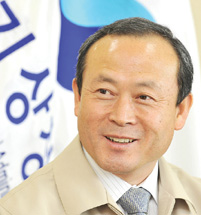KMA Upgrades Weather Forecast Systems
Puts meteorological satellite into orbit and inaugurates the National Meteorological Super Computer Center

The Korea Meteorological Administration (KMA) has steps in place to dramatically improve the nation's weather forecasting accuracy with the goal of raising the nation's standing in forecasting capability from the current 10th place in the world to sixth place by 2012.
The KMA announced comprehensive plans to improve its weather forecasting capability as it is inaugurating the nation's third super computer for meteorological services at the new National Meteorological Super Computer Center in Ochang, Chungcheongbuk-do. The center, designed to house a numerical model management system, was built at a cost of 35.3 billion won on a site of 23,092 square meters. The KMA said the introduction of the XT5-Baker-class super computer No. 3 from Kray of the United States at a cost of 50.2 billion won is expected to dramatically improve weather forecasting speed. The latest super computer will be on line after the conclusion of test operations by the end of this year. In theory, it is capable of finishing in one minute the calculations equivalent to one year of work by 554 million people.
In another effort to improve forecasting accuracy, the KMA plans to replace the Global Data Assimilation and Prediction System (GDAPS) from Japan and the Regional Data Assimilation and Prediction System (RDAPS) from the United States with the United Kingdom Meteorological Office's unified model starting from May. A model capable of calculating by dividing the surface of the earth and space minutely will be adopted from early next year.

The KMA said Korea's first meteorological satellite, COMS, a multipurpose satellite for meteorological, communication and oceanographic services, to be put in orbit in late April, will also contribute to enhancing weather forecasting accuracy. In 2003, the KMA began the development of the satellite together with the Ministry of Education, Science and Technology and the Ministry of Land, Transport and Maritime Affairs at a cost of 350 billion won, 75 billion won of which was shouldered by the KMA.
The satellite will be capable of conducting meteorological surveillance around the clock, as it will be fitted with a meteorological censor that will allow for night observations using infrared rays. This will likely not only raising Korea's national standing, but also bring about practically useful benefits.
Korea has so far depended on Japan to receive satellite data at an interval of 30 minutes to issue weather forecasts. Korea will be able to make observations at any time and place with the new satellite. The satellite is expected to be a boon for weather forecasting and early predictions of dangerous weather.
Korea's launching of its own meteorological service with remote-sensing equipment has the symbolic meaning of being technologically independent, departing from its dependence on advanced countries.
It also means that the nation's meteorological services can be expanded to space. Starting with the launch of the satellite of meteorological, communication and oceanographic services, the KMA plans to aggressively conduct space-based weather and environment surveillance around the globe by participating in the development of a geostationary, multipurpose satellite.

The KMA appointed Prof. Kenneth Crawford, a U.S. meteorological authority, to head the advancement of Korea's meteorological affairs last August with the mission of innovating for the KMA's take-off by analyzing the overall business and embracing advanced countries's meteorological policies and responses to climate change and advancing observation systems. He is now working on the strategies for the development of the KMA. Prof. Crawford, a prominent authority in the meteorological field with 30 years of field experience with the U.S. National Weather Service, is considered to be a meteorologist with the field experience and academic career that best fits Korea's needs. In particular, an authority in weather forecasting, radar meteorology and climatology, Crawford has attained profound field experiences while holding various posts including chairman of the American Meteorological Society.
The KMA is seeking to be an exemplary case of successfully improving systems and technologies in a short period of time by making the most of Crawford's expertise recognized in his home country. This is expected to raise Korea's position in the international meteorological field.
Thanks to the KMA's efforts to promote international cooperation, Korea has been awarded the right to host the 32nd Session of the Intergovernmental Panel on Climate Change (IPCC) in Busan in October and the 4th Session of the Joint WMO-IOC Technical Commission for Oceanography and Marine Meteorology (JCOMM) in Yeosu in 2012, he said. About 1,000 meteorological experts and government officials from Korea and abroad will converge for the upcoming IPCC conference. nw
(top) Chun Byung-seong, administrator of the Korea Meteorological Administration, speaks during a ceremony marking World Meteorological Day at the Korea Press Center in Seoul on March 23. Dignitaries, including KMA Administrator Chun, cut the tape to open an exhibition on historical materials of meteorology and meteorological photos at the Gwacheon National Science Museum later on the same day.
The KMA has inaugurated the nation's third supercomputer for meteorological services at the new National Meteorological Supercomputer Center in Ochang, Chungcheongbuk-do.
Chun Byung-seong, administrator of the Korea Meteorological Administration
3Fl, 292-47, Shindang 6-dong, Chung-gu, Seoul, Korea 100-456
Tel : 82-2-2235-6114 / Fax : 82-2-2235-0799